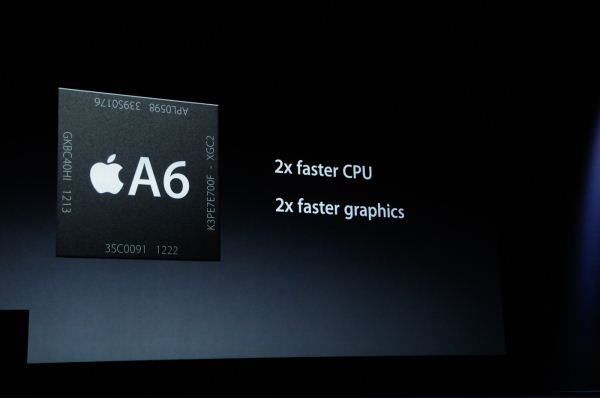The iPhone 5's A6 SoC: Not A15 or A9, a Custom Apple Core Instead
by Anand Lal Shimpi on September 15, 2012 2:15 PM EST- Posted in
- Smartphones
- Apple
- Mobile
- SoCs
- iPhone 5
The A6 GPU: PowerVR SGX 543MP3?
Apple made a similar "up to 2x" claim for GPU performance. It didn't share any benchmarks, but there are four options here:
1) PowerVR SGX 543MP2 (same as in A5) at 2x the clock speed
2) PowerVR SGX 543MP4 at the same clock as the MP2 in the A5
3) Marginally higher clocked PowerVR SGX 543MP3
4) Next-gen PowerVR Rogue GPU
It's too early for #4. The first option makes sense but you run into the same issues as on the CPU side with higher voltages used to ramp clocks up (also possible that you drop voltages in the move to the new process technology).
The second option trades voltage for die area, which based on the A5X Apple is clearly willing to spend where necessary.
The third is sort of the best of both worlds. You don't take a huge die area penalty and at the same time don't run at a significantly higher frequency, and you can get to that same 2x value.
The third option is the most elegant and likely what Apple chose here. Remember that overall die size is dictated by the amount of IO you have around the chip. The A5X had four 32-bit LPDDR2 memory controllers, which gave Apple a huge die area to work with. The move to a smaller manufacturing process cuts down the total die area, which means Apple would either have to add a ton of compute (to fill empty space, no sense in shipping a big chip with a bunch of unused area) or reduce the memory interface to compensate. Pair that knowledge with the fact that Apple doesn't have the same memory bandwidth requirements on the iPhone 5 (0.7MP vs. 3.1MP display) and it makes sense that Apple would go for a narrower memory interface with the A6 compared to the A5X.
How much narrower? Phil Schiller mentioned the A6 was 22% smaller than the A5. We can assume this is compared to the 45nm A5 and not the 32nm A5r2, which would mean that we don't have any more memory channels compared to the A5. In other words, it's quite likely the A6 has a 2x32-bit LPDDR2 memory interface once again.
Final Words
There's not much more to add for now. We'll have a device in a week and I suspect the first reviews will be out a day or two before then. Then the real work begins on finding out exactly what Apple has done inside the A6. If anyone has been dying to put together some good low level iOS benchmarks, now is the time to start.
This is a huge deal for Apple. It puts the company in another league when it comes to vertical integration. The risks are higher (ARM's own designs are tested and proven across tons of different devices/platforms) but the payoff is potentially much greater. As Qualcomm discovered, it's far easier to differentiate (and dominate?) if you're shipping IP that's truly unique from what everyone else has.
Now we get to see just how good Apple's CPU team really is.











163 Comments
View All Comments
aNYthing24 - Saturday, September 15, 2012 - link
Krait also supports VFPv4, right?Ryan Smith - Saturday, September 15, 2012 - link
Correct.tipoo - Saturday, September 15, 2012 - link
Looking forward to knowing if it's faster than Krait.Flunk - Sunday, September 16, 2012 - link
They could have just licensed Krait or Exynos (less likely ;)) and slapped it in like they did with previous chipstipoo - Sunday, September 16, 2012 - link
Is Qualcomm licencing out Krait? I thought they've only produced it on their own and sold the whole chips.frostyfiredude - Sunday, September 16, 2012 - link
They have historically, so I don't think this is krait. But if Apple wanted to license Krait and were willing to pay a fair price I wouldn't be too surprised if they would work out a deal. 50+ million devices will ship with the A6 so that's a lot of revenue potential that they wouldn't otherwise get with their limited fab output.lowlymarine - Sunday, September 16, 2012 - link
Exynos uses off-the-shelf ARM cores, as far as I'm aware. Historically, Qualcomm doesn't license its architectures, but they are already providing a lot of IP for these new iPhones, so it's far from impossible. Certainly as believable as the idea that the engineers who gave us the worst antenna design in the history of cellular communications could have designed their own CPU core.A5 - Sunday, September 16, 2012 - link
If you think RF and CPU Architecture would have the same teams, you're being silly. Come on.capasicum - Monday, September 17, 2012 - link
Certainly you've only read the media coverage, and skipped the fact that every phone has it's own "death grip".I'm a left-hander and own one of those iPhones 4 with the crappy antenna. And, I live in Eastern Europe (bad technology adoption, etc). Might seem strange, but I haven't had the "death grip" experience. Not once.
More over, the engineers responsible for the CPU have nothing to do with the antenna. "Engineer" is a title, not a position, you know.
Also, what's been done with the antena of current models (4S and 5) is a couple of minor changes. The general antenna design stays.
tobi1449 - Monday, September 17, 2012 - link
Certainly you've read it wrong and skipped the fact that this is not the usual issue where your connection becomes unstable and weaker when you enclose the antennas with your hands.The death-grip on the Iphone 4 worked different because you were able to short-circuit the antennas directly (which you can't do with any other phone I know) and the signal instantly dropped to 0.